Iowa’s Raccoon River Valley Trail
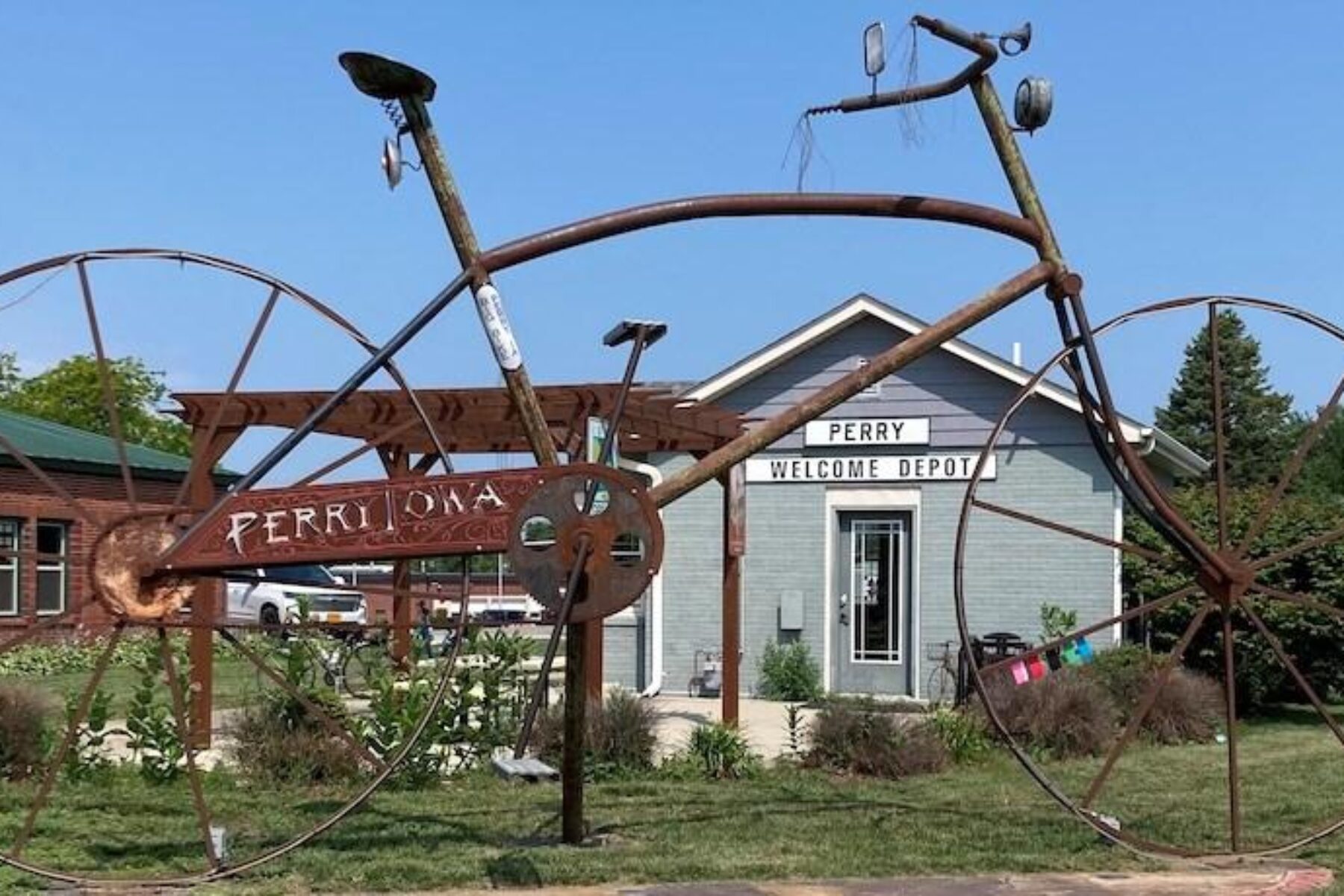
Trail of the Month: Sept. 2021
“The Raccoon River Valley Trail is now a major economic force for west-central Iowa. It connects Des Moines, the largest city in Iowa and the state capital, to some of the richest, most productive farmland in America.”
—Chuck Offenburger, a former Raccoon River Valley Trail Association board member
In pastoral west-central Iowa, the Raccoon River Valley Trail has won this year’s blue-ribbon prize: entrance into the Rail-Trail Hall of Fame. The 89-mile pathway garnered some 16,000 votes in the national competition—a figure larger than the population of most of the small towns along its route, several home to fewer than 300 people.
“The surrounding communities get that rising tides lift all boats,” said Andrea Boulton, trails and greenways program director for the Iowa Natural Heritage Foundation. “When they see the Raccoon River Valley Trail get that national recognition, they’re like, ‘Look what’s happening here in Iowa!’ It’s an amazing facility, and we can have more of that in the state—it’s a prime example of what’s possible.”
Leaving the outskirts of Des Moines, the route swoops west and north through a Midwestern canvas awash in color: emerald expanses of farmers’ fields, meadows flecked with wildflowers, and glimmers of silver silos. It’s a vivid backdrop that will only be enhanced with the coming flourishes of fall.
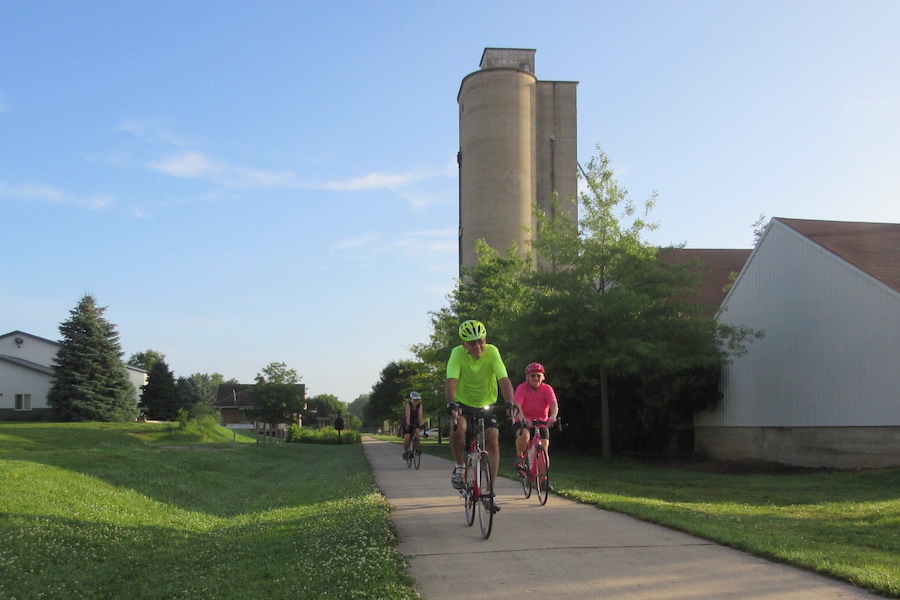
“You get to experience the harvest season in Iowa as you’re riding along—we’re known for our corn and beans—and the fall foliage is beautiful, especially along the southern loop of the trail,” enthused Deb Bengston, director for the chamber of commerce of Adel, one of the 14 charming communities along the trail. “There are maples, oaks and elms; the colors stay so vibrant for a longer time because you’re seeing all different species of trees.”
Owned by the conservation boards of the three counties it traverses—Dallas, Greene and Guthrie—a central tenant of the trail’s management is providing public access to nature and these picturesque settings.
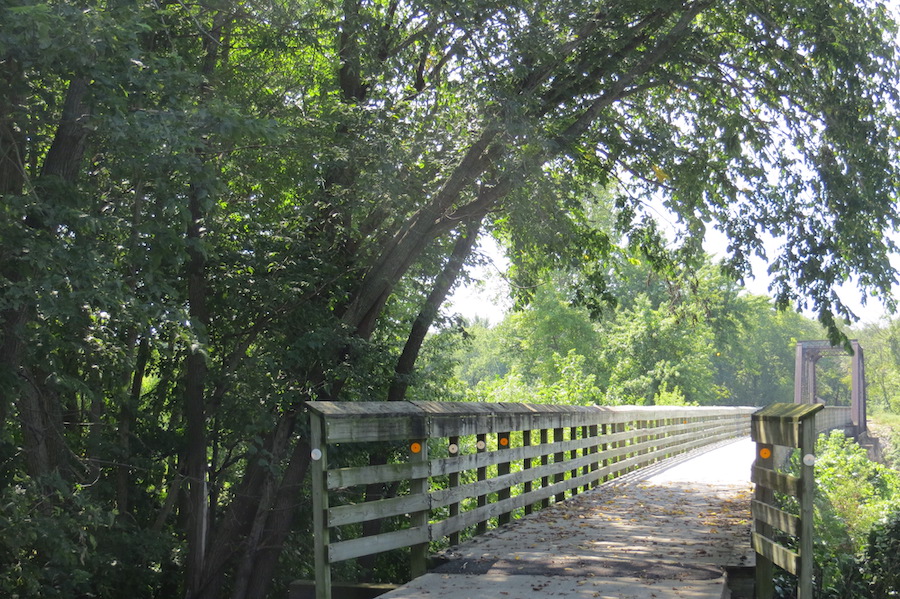
“By building the trail and preserving the railroad right of way, we’ve actually preserved a lot of wildlife habitat,” noted Mike Wallace, director of the Dallas County Conservation Board. “We have a lot of tree-shaded portions of the trail, and it goes through some prairie remanent areas, so you see a lot of wildlife: deer, quails, pheasants and other types of birds.”
Each June, the trail even smells delicious thanks to the Bacoon Ride, a fundraiser for the Iowa Bicycle Coalition drawing hundreds of people to the area. The all-day ride starts and ends in Waukee, on the eastern leg of the pathway, and bacon-themed delights of all kinds—donuts, ice cream, sandwiches, cornbread and more—are served in the towns along the way. Other events take place on the trail throughout the year, an unanticipated but welcome community benefit since the trail’s creation in 1989, according to Wallace.
Blazing Trail
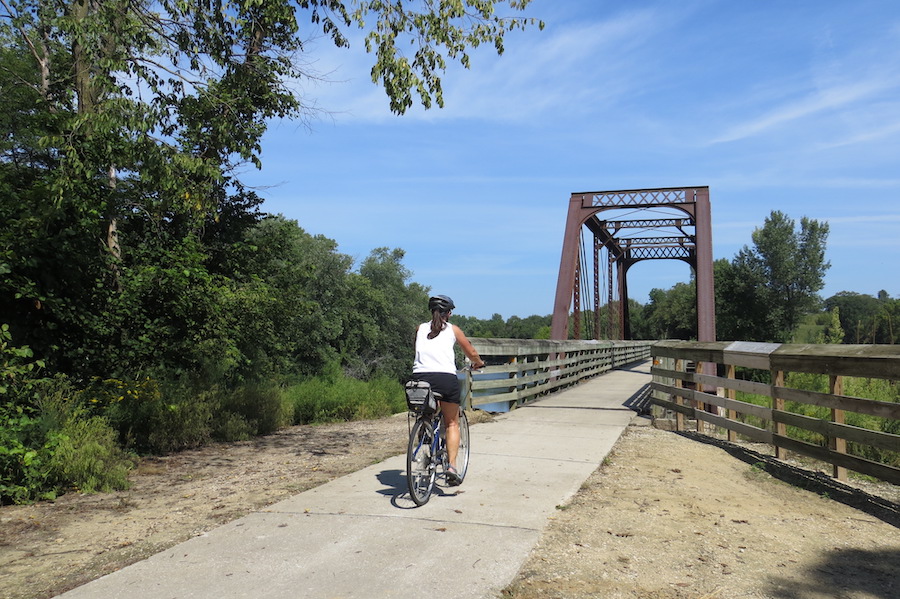
Its distinctive loop—in fact, the largest paved loop trail in the country—is special in two ways. The trail began more simply with a straight-forward, 34-mile route from Waukee to Yale. And back then, most of the trails around the state were crushed limestone. The Raccoon River Valley Trail set the trend for hard-surfaced trails into the 1990s and 2000s, Wallace noted.
In the years that followed the 1989 opening, the trail was extended outward from its tips—north to Jefferson and east to Clive, then totaling 56 miles—but the gamechanger occurred nearly two decades after the original section opened. In 2006, a nonprofit group, the Raccoon River Valley Trail Association, was formed and tasked with fundraising and promoting the trail. Not long after, they were about to get a really big assignment.
“When Mike Wallace first called me in 2008 and said we have an opportunity to get a 33-mile route from Union Pacific, but it will cost about $8 million to develop it, my first thought was, ‘Oh, crap! Do we really want to take that on?’” recalled Chuck Offenburger, a former Raccoon River Valley Trail Association board member who was instrumental in the group’s creation. “We did—and it’s the best thing that ever happened. It took it from a nice regional trail into a national treasure.”
An instrumental partner in these trail expansions over the past two decades has been the Iowa Natural Heritage Foundation, a nonprofit group based in Des Moines that operates statewide.
“They encourage private landowners to donate land for conservation and recreational use,” said Offenburger. “This is so important as we don’t have much public land in Iowa because the farm ground is so good, and the state is heavily dedicated to agriculture. When we added the loop, they helped us by taking ownership of the corridor from the railroad and turning it over to the conservation board.”
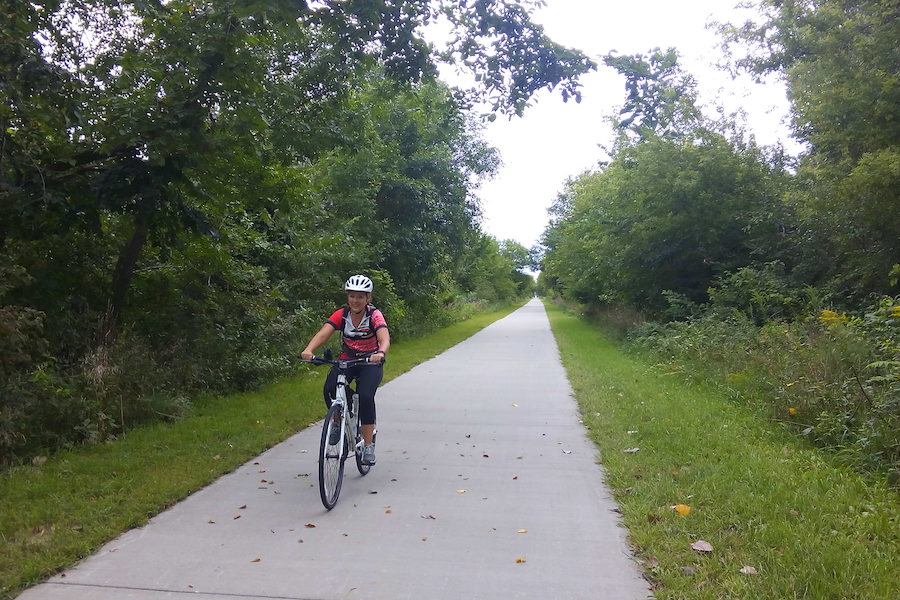
Once the 33-mile addition clicked into place in 2013, an expansive and seamless trail loop was formed with two small offshoots at either end of the circle, like a piece of wrapped penny candy. But novice adventurers should not be put off by the trail’s current 89-mile length. With so many towns en route, there is no shortage of amenities to meet traveler’s needs, including bathrooms, food and rest areas.
“What I really appreciate about the trail is that you can bike 6–10 miles, and there’s going to be something for you to pull off to see and do,” affirmed Bengston.
A Quiet Little Trail Becomes a Big Success
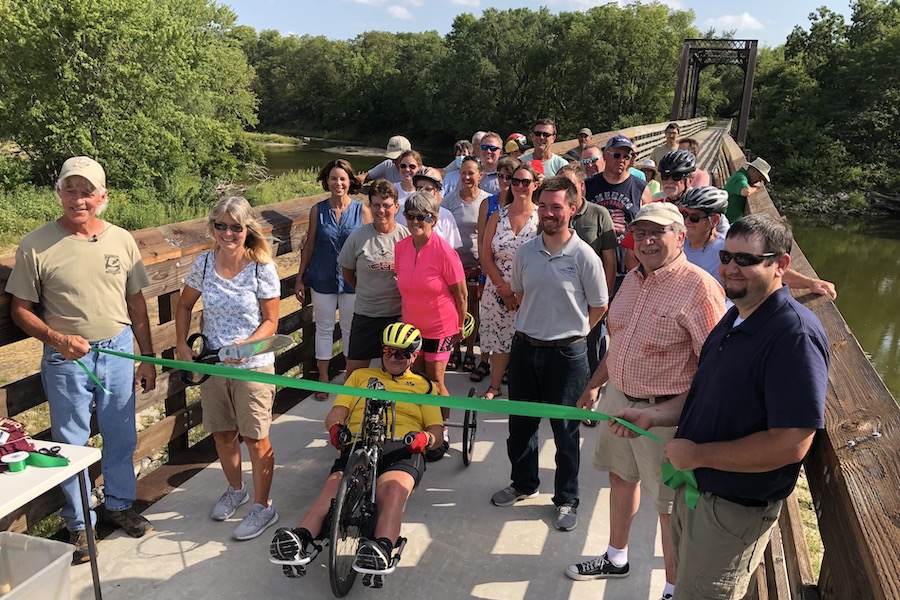
While the trail’s name was an easy and swift decision—it comes from the branches of the Raccoon River that frequently appear alongside the trail or under its bridges—one thing that proved more challenging was branding the trail. Help came in the form of students.
“We contacted the Iowa State University College of Design, and they took on the development of the trail’s logo as one of their design projects,” explained Wallace. “There were three or four different teams from this class that took on this design project, and they all submitted their ideas for the logo design. In the end, we combined some of the ideas into one: the raccoon emblem, the color scheme and the diamond shape that the raccoon is placed on.”
It was the start of a marketing campaign that spurred greater trail usage and energized the communities surrounding the route.
“It was just a quiet little trail; Dallas County Conservation rider surveys from the early years showed about 75,000 people using the trail each year—and people thought that was a big deal,” Offenburger said. “But from our experience with researching other trails, we said our goal should be to have 350,000 a year on the trail. All we have to do is tell them it’s here and point out the amenities we have—and keep improving those—and they’ll come.”
As improvements along the trail—including new signage, public art, depot restorations and other amenities—developed over time, pride in trail grew and, with it, a realization of its benefits, spurring related positive changes in the trail towns. It’s work that has “set the bar on best practices for how to do things right,” noted Boulton.
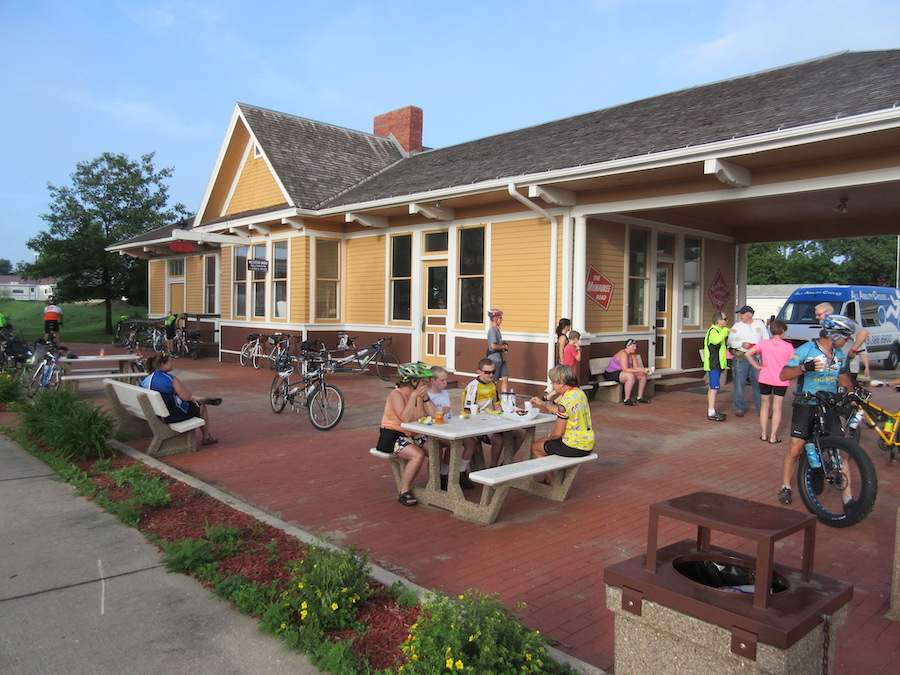
“We’ve seen the towns step up and improve their local parks because the trail goes right by, or improve their trailheads because they want people to come to their town and stay for a while and spend some money,” said Wallace. “Bed-and-breakfasts, bike shops, sports bars and other businesses have popped up because of the trail being created. It’s been good for the communities; they’ve seen the advantage of all these people coming through, and they’re doing some great things to keep them around.”
Bengston beamed about one such project for Adel, a city of about 6,000 on the trail’s southern loop. “With this trail being on an old rail bed, it doesn’t always go through the best part of the community; sometimes it’s the part of the community that has been the most neglected. We took a four-block area around it and really did a lot of landscaping. We had 108 volunteers donate over 500 hours to plant shrubs, perennials and trees. It’s something that really brought the community together.”
She also points out that these positive changes not only draw tourists, but also entice new residents. “In the last four or five years, we’ve noticed people coming up and saying, ‘I moved here because I biked around and explored the community and fell in love with it.’”
Bright Future
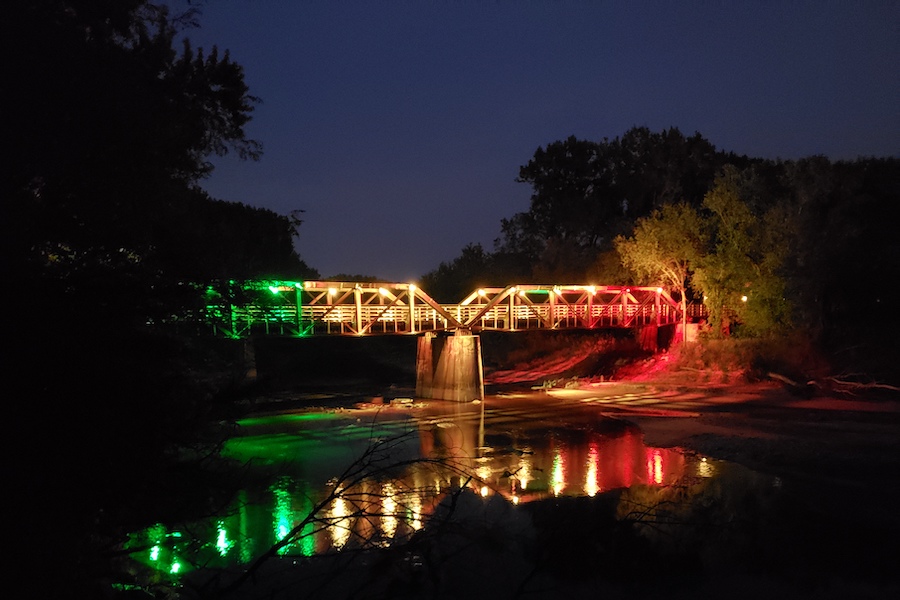
In the last few years, a cascade of exciting projects—including a showstopper in Adel—has been rippling down the trail, enhancing the experience and luring in new travelers and supporters.
“We had always felt that the Raccoon River bridge could be an awesome part of the trail, so we added 66 LED color-changing lights,” said Bengston. “Now we have a lighted bridge welcoming the bikers, joggers, walkers and families into Adel. The colors change monthly, and we try to do something different every time to make it unique. People love it! They tell me that they go down to the bridge the first of every month to see what the new bridge colors will look like.”
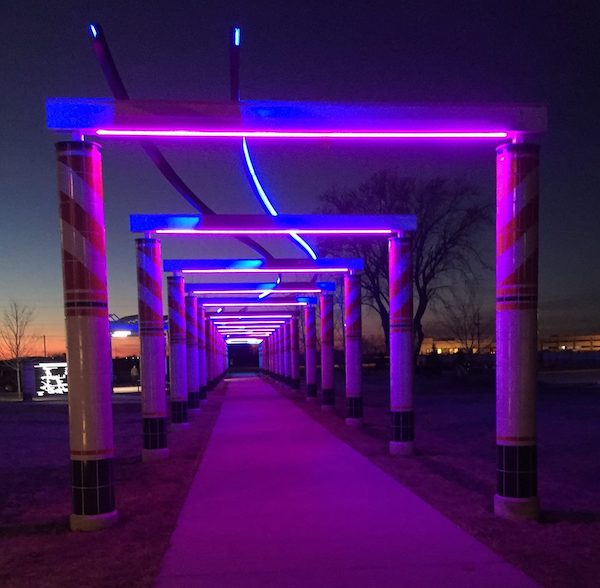
In nearby Waukee, a stunning new art piece enlivens the trailhead there. Created by David Dahlquist, the same Iowan artist who designed the famed centerpiece bridge of the High Trestle Trail, the Waukee Railroad Pergola feels both futuristic and historical.
“It’s a very colorful red, white and black design that looks like a railroad path above you for 350 feet,” described Offenburger. “It’s lighted at night over the trail and is a tribute to the rail heritage of these communities. Now, the trail continues to function as the railroad once did, as a method of exchange between the towns.”
It’s a fitting addition given current efforts to connect the Raccoon River Valley Trail to the High Trestle Trail, which spans 28 miles through Des Moines’ northern suburbs. Dubbed the “Let’s Connect Trail Project,” the burgeoning route would span 9 miles between Perry and Woodward.
“Last year, we did a mile of paving on the Woodward end, and then three years ago, we did a mile and a half on the Perry end,” elaborated Wallace. “As we speak, we’re doing another mile of paving on the Woodward end and another half-mile on the Perry end. Plus, we’re building a bridge across a major creek along the connector. By the end of the year, it’ll be close to halfway built.”
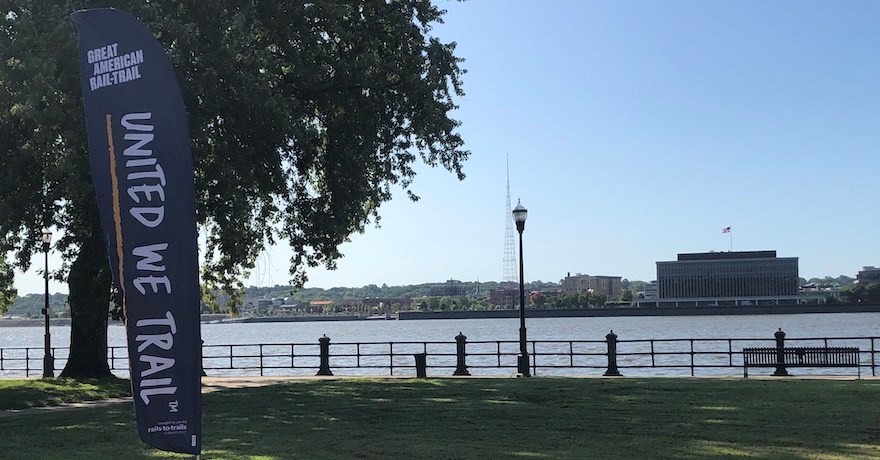
As if connecting two of the state’s premier trails wasn’t thrilling enough, both are also part of the Great American Rail-Trail™, a developing 3,700-mile route across the country between Washington, D.C., and Washington State.
“The Raccoon River Valley Trail is now a major economic force for west-central Iowa,” noted Offenburger. “It connects Des Moines, the largest city in Iowa and the state capital, to some of the richest, most productive farmland in America.”
When reflecting back on his decades of work as a trail advocate in the state, he is optimistic about the future. “Rail-trails have given new life to a whole bunch of small towns that got clobbered when the railroads were pulling out. They thought they’d met their end because the railroads were such a storied contributor to the economic base of the communities, but the trails have given them more people than the trains ever brought, and they’ve learned to cater to them in different ways. When these trails first started, I thought they could be the best thing that’s happened in Iowa in my lifetime—and 35 to 40 years later, they are!”
Related Links
- Raccoon River Valley Trail Association
- Dallas County Conservation Board
- Greene County Conservation Board
- Guthrie County Conservation Board
- Iowa Natural Heritage Foundation
Trail Facts
Name: Raccoon River Valley Trail
Used railroad corridor: The original railroad operating in the corridor was the Des Moines Northern and Western Railroad (circa the 1880s). Later railroad companies utilizing the corridor included the famed Milwaukee Road and the Union Pacific Railroad.
Trail website: Raccoon River Valley Trail Association
Length: 89 miles
Counties: The Raccoon River Valley Trail is owned and managed by the three county conservation boards: Dallas, Guthrie and Greene.
Start point/end point: The eastern end of the trail begins in Clive on the outskirts of Des Moines; at this end, it meets the Clive Greenbelt Trail, just south of Hickman Road and west of N.W. 128th Street. From there, the trail heads west to Waukee, where travelers will find a stunning trailhead art piece called “Waukee Railroad Pergola: In the Shadow of the Rails,” as well as a Y junction that marks the beginning of the trail’s loop. Each leg of the loop travels through a handful of communities before rejoining in Herndon. From that juncture, the trail then heads north, ending at E. Lincolnway Street in Jefferson.
Surface type: Asphalt, concrete
Grade: The trail is largely flat with only a 1–2% grade.
Uses: The trail is available for walking, bicycling, wheelchair use and inline skating. In the winter, the trail provides opportunities for cross-country skiing, as well as snowmobiling in some sections as long as there is a minimum of 4 inches of snow.
Getting there: The Des Moines International Airport (5800 Fleur Drive, Des Moines) is about 20 miles from the trail’s eastern end.
Access and parking: A trail permit is required for trail users 18 years of age or over. An annual permit can be purchased online for $10. Alternatively, travelers can purchase a daily pass for $2 at any trailhead, or from the Dallas County Conservation Board administration office (14581 K Ave., Perry), located a half-mile off the trail, during business hours. The proceeds are used by the conservation boards in the trail’s three counties for trail maintenance and improvements.
Trailhead parking is available in most of the towns that the trail connects, including at each end of the trail—in Waukee (US 6 and N. 10th Street) to the south and at the Milwaukee Railroad Depot (591 E. Lincoln Way, Jefferson) to the north. For a detailed list of the services available along the route, check the Trail Towns page of the Raccoon River Valley Trail Association’s website.
To navigate the area with an interactive GIS map, and to see more photos, user reviews and ratings, plus loads of other trip-planning information, visit TrailLink.com, RTC’s free trail-finder website.
Rentals: Although trail advocates would like to offer bike rental services along the route, that service is not currently available in any of the trail towns or in Des Moines. However, in the north Des Moines suburb of Ankeny, about 25 miles from the east end of the Raccoon River Valley Trail, Bike Country (825 East 1st St., Ankeny; phone: 515.964.5623) does offer four-hour, one-day and three-day bike rentals.

Donate
Everyone deserves access to safe ways to walk, bike, and be active outdoors.
